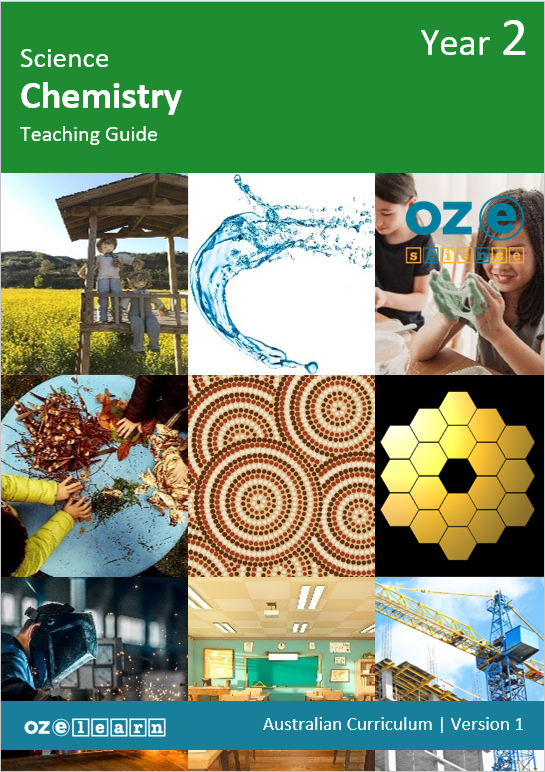Oz-e-science

Extra resources
In Lessons 1 to 9, students learn about:
- natural materials
- identifying objects that are made from natural materials in the schoolyard or on a scavenger hunt
- human-made materials
- researching materials that are made from atoms
- materials that are combined or mixed
- mixing materials to make slime
- some traditional materials used by Indigenous Australians
- using traditional materials to make art
- how materials can be reduced, reused, and recycled
- how they can reduce, reuse, or recycle in their lunch order
- how we can repurpose and repair unwanted materials
- experimenting to repurpose toilet rolls
- the James Webb Space Telescope
- making a model of the James Webb Telescope
- weatherproof materials
- making a model of a weatherproof shelter
- building the model weatherproof shelter and testing it to see if it will protect the doll from the weather
- making and testing their shelter for its weatherproofing.
- Find natural materials.
- Sort objects made from natural materials.
- Find material in the schoolyard that are used to make useful things.
- Find human-made materials.
- Sort things made from human-made materials.
- Inspect human-made materials by looking at the elements on the element table.
- Find materials that are mixed.
- Sort the combined materials in a mixed material.
- Investigate mixed materials by making slime.
- Find materials that are traditional.
- Sort the materials in traditional objects.
- Experiment with traditional materials by making paint.
- Analyse materials that can be reduced, reused, or recycled.
- Sort objects that could be recycled.
- Explain how one can reduce, reuse, and recycle in their own lunch.
- Analyse materials that can be repurposed or repaired.
- Communicate ways that we could repurpose or repair unwanted objects.
- Experiment with toilet rolls to repurpose them as planters.
- Analyse materials that are used in spacecraft.
- Describe the properties of the materials used to make spacecraft.
- Make a model of the James Webb Telescope.
- Analyse materials that are weatherproof.
- Describe the properties of weatherproof materials.
- Make a model of a weatherproof shelter.
- Predict if the model will work against extreme weather.
- Experiment with the model to find out if it can protect from extreme weather.
Progress Tests
Progress tests are conducted after every second lesson, allowing teachers to monitor student understanding of the concepts taught over the past two lessons and to identify where reteaching is needed. The Teaching Guide contains the testing questions, and the Student Workbook has a section where students write their answers and score themselves.
Structured Research Activity
The Structured Research Activity (SRA) for this unit is: Students design and make a weatherproof shelter; make predictions and experiment on the shelter and report results. The SRA takes place over two lessons so students can apply the Science Understanding and Science Inquiry Skills covered in the unit. Teachers use the Guide to Making Judgements, which is included in the Teaching Guide, to mark the SRA.
End-of-Unit Assessment
The last lesson is the end-of-unit assessment, which has a variety of question formats (e.g. label the diagram, circle the correct answer) to assess student mastery of content from the unit. The end-of-unit assessment is in the Teaching Guide. Teachers copy the assessment and distribute to students at testing time.
Progress tests are conducted after every second lesson, allowing teachers to monitor student understanding of the concepts taught over the past two lessons and to identify where reteaching is needed. The Teaching Guide contains the testing questions, and the Student Workbook has a section where students write their answers and score themselves.
Structured Research Activity
The Structured Research Activity (SRA) for this unit is: Students design and make a weatherproof shelter; make predictions and experiment on the shelter and report results. The SRA takes place over two lessons so students can apply the Science Understanding and Science Inquiry Skills covered in the unit. Teachers use the Guide to Making Judgements, which is included in the Teaching Guide, to mark the SRA.
End-of-Unit Assessment
The last lesson is the end-of-unit assessment, which has a variety of question formats (e.g. label the diagram, circle the correct answer) to assess student mastery of content from the unit. The end-of-unit assessment is in the Teaching Guide. Teachers copy the assessment and distribute to students at testing time.
Oz-e-science applies a teaching approach and curriculum that uses explicit teaching of content and knowledge of science as well as explicit teaching and practical scientific inquiry using the Scientific Method. Read more about pedagogy here.

